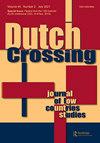Worlding Modern Literature in the Low Countries
IF 0.4
3区 历史学
Q1 HISTORY
Dutch Crossing-Journal of Low Countries Studies
Pub Date : 2022-12-01
DOI:10.1080/03096564.2022.2144596
引用次数: 0
Abstract
In 2007, the Flemish-Moroccan writer Rachida Lamrabet published her debut novel Vrouwland. The main narrative centres around Younes, a Moroccan adolescent who meets Mariam, a Flemish-Moroccan girl who is spending some time in Morocco during the summer. They fall in love and the day before Mariam leaves, Younes asks her to marry him. Jestingly, she agrees. But back in Belgium, she never responds to his letters. Finally, having obtained a university degree but struggling to find decent employment and with several years of unresponded letters sent to Yasmine, Younes decides to travel to Belgium to search for his long lost love and, perhaps, to build a better future for himself. But the boat that transports him is shipwrecked and Younes drowns in his attempt to reach the European mainland. Interwoven with this heartbreaking story of unrequited love, migration and adolescent aspiration for a better life are a myriad of adjacent stories of characters that lead their lives in a world in which Belgium and Morocco, Europe and Africa are not separate entities but closely intertwined worlds. When Lamrabet’s novel was published, it was hailed as a turning point in Belgian Neerlandophone literature addressing the topic of migration in the Low Countries. Vrouwland was welcomed as a superb form of migrant literature, a genre that in ‘Belgian Neerlandophone [literature] . . . started to flourish only in the 2000s and has principally been led by second generation Moroccan-origin authors.’ Lamrabet was seen as part of that new generation addressing the intricacies of migration in Belgium. Migration obviously plays a crucial role in Vrouwland. Yet, what is truly striking about the characters and their stories, is how the world they navigate was a self-explanatory web of multiple regions and ways of life, woven into each other in the way that life, as it unfolds, tends to do. In that sense, rather than allowing itself to be compartmentalized in the literary subgenre of migrant literature, Lamrabet’s novel invites us to reflect on outdated compartments like the national framework in which we tend to read and interpret many of the literary works that are produced within the Low Countries. Like the characters of Vrouwland, the Low Countries is a region that has always already been shaped by different regions, cultures, ways of life. The challenge for modern Neerlandophone literature is perhaps less to subcategorize this insight into a specific literary genre, but to become attentive to the presence of this phenomenon in literature itself. Neerlandophone literature from the Low Countries is thoroughly embedded in a globalized world and when studied up close it provides ample representations of the lingual and cultural superdiversity of the region as well as its enmeshment with global culture. In most Neerlandophone literature we find characters, perspectives and低地国家的世界现代文学
2007年,佛兰德裔摩洛哥作家Rachida Lamrabet出版了她的处女作《荒原》。故事主要围绕尤尼斯展开,尤尼斯是一个摩洛哥青少年,他遇到了玛丽亚姆,一个夏天在摩洛哥度过一段时间的佛兰德裔摩洛哥女孩。他们坠入爱河,在玛丽安离开的前一天,尤尼斯向她求婚。她开玩笑地表示同意。但回到比利时后,她从不回他的信。尤尼斯获得了大学学位,但却很难找到一份体面的工作,多年来他一直没有给雅斯明回信。最后,尤尼斯决定去比利时寻找他失散已久的爱人,也许是为自己创造一个更好的未来。但是运送他的船失事了,尤尼斯在试图到达欧洲大陆的途中淹死了。在这个令人心碎的单恋、移民和青少年对更好生活的渴望的故事中,交织着无数相邻的人物故事,他们在比利时和摩洛哥、欧洲和非洲不是独立的实体,而是紧密交织在一起的世界中生活。兰拉贝特的小说出版后,被誉为比利时尼兰德语文学的转折点,它探讨了低地国家的移民问题。voulland作为一种优秀的移民文学形式而受到欢迎,这种类型在“比利时荷兰语文学”中…直到2000年代才开始蓬勃发展,主要由第二代摩洛哥裔作家领导。Lamrabet被视为解决比利时复杂移民问题的新一代中的一员。移民显然在荷兰起着至关重要的作用。然而,这些人物和他们的故事真正引人注目的是,他们所驾驭的世界是一个由多个地区和生活方式组成的不言自明的网络,以生活的方式相互交织,随着生活的展开,往往会这样做。从这个意义上说,Lamrabet的小说并没有让自己被划分为移民文学的亚类型,而是邀请我们反思过时的划分,比如我们倾向于阅读和解释低地国家创作的许多文学作品的国家框架。就像弗劳兰德的人物一样,低地国家是一个一直被不同的地区、文化和生活方式所塑造的地区。现代荷兰语文学面临的挑战可能不是将这种洞察力归类到特定的文学体裁中,而是要注意到这种现象在文学本身中的存在。来自低地国家的荷兰语文学完全融入了全球化的世界,当仔细研究它时,它提供了该地区语言和文化超级多样性的充分代表,以及它与全球文化的融合。在大多数荷兰语文学中,我们可以找到人物,视角和
本文章由计算机程序翻译,如有差异,请以英文原文为准。
求助全文
约1分钟内获得全文
求助全文

 求助内容:
求助内容: 应助结果提醒方式:
应助结果提醒方式:


